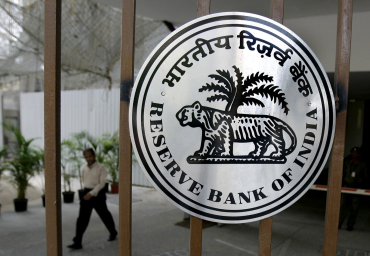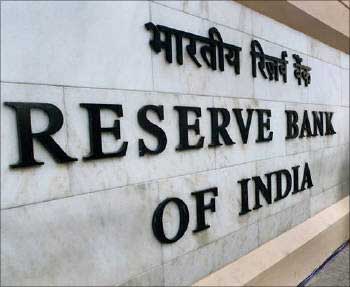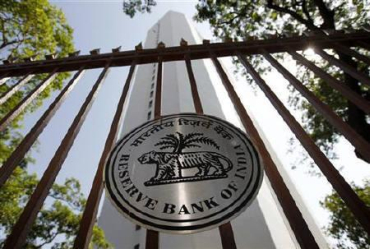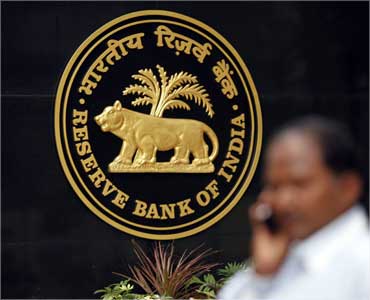 | « Back to article | Print this article |
RBI releases draft norms to set up new private banks
The Reserve Bank of India on Monday released the draft norms for licensing of new banks in the private sector, pegging the minimum capital requirement at Rs 500 crore (Rs 5 billion).
The key features of the draft guidelines are:
(i) Eligible promoters: Entities/groups in the private sector, owned and controlled by residents, with diversified ownership, sound credentials and integrity and having successful track record of at least 10 years will be eligible to promote banks.
Entities/groups having significant (10 per cent or more) income or assets or both from real estate construction and/or broking activities individually or taken together in the last three years will not be eligible.
Click NEXT to read on . . .
RBI releases draft norms to set up new private banks
(ii) Corporate structure: New banks will be set up only through a wholly owned Non-Operative Holding Company (NOHC) to be registered with the Reserve Bank as a non-banking finance company (NBFC) which will hold the bank as well as all the other financial companies in the promoter group.
(iii) Minimum capital requirement: Minimum capital requirement will be Rs 500 crore.
Subject to this, actual capital to be brought in will depend on the business plan of the promoters. NOHC shall hold minimum 40 per cent of the paid-up capital of the bank for a period of five years from the date of licensing of the bank.
Click NEXT to read on . . .
RBI releases draft norms to set up new private banks
Shareholding by NOHC in excess of 40 per cent shall be brought down to 20 per cent within 10 years and to 15 per cent within 12 years from the date of licensing of the bank.
(iv) Foreign shareholding: The aggregate non-resident shareholding in the new bank shall not exceed 49 per cent for the first 5 years after which it will be as per the extant policy.
(v) Corporate governance: At least 50 per cent of the directors of the NOHC should be independent directors. The corporate structure should be such that it does not impede effective supervision of the bank and the NOHC on a consolidated basis by the Reserve Bank.
Click NEXT to read on . . .
RBI releases draft norms to set up new private banks
(vi) Business model: Should be realistic and viable and should address how the bank proposes to achieve financial inclusion.
(vii) Other conditions:
a. The exposure of bank to any entity in the promoter group shall not exceed 10 per cent and the aggregate exposure to all the entities in the group shall not exceed 20 per cent of the paid-up capital and reserves of the bank.
b. The bank shall get its shares listed on the stock exchanges within two years of licensing.
Click NEXT to read on . . .
RBI releases draft norms to set up new private banks
c. The bank shall open at least 25 per cent of its branches in unbanked rural centres (population upto 9,999 as per 2001 census)
d. Existing NBFCs, if considered eligible, may be permitted to either promote a new bank or convert themselves into banks.
(viii) In respect of promoter groups having 40 per cent or more assets/income from non-financial business, certain additional requirements have been stipulated.
Click NEXT to read on . . .
RBI releases draft norms to set up new private banks
Background
It may be recalled that pursuant to the announcement made by Union Finance Minister Pranab Mukherjee in his budget speech and the Reserve Bank's Annual Policy Statement for the year 2010-11, a discussion paper on 'Entry of new banks in the private sector' was placed on RBI website on August 11, 2010.
The discussion paper marshalled international practices, Indian experience as well as the extant ownership and governance (O&G) guidelines.
The Reserve Bank had sought views/comments from banks, non-banking financial institutions, industrial houses, other institutions and the public at large. Discussions were also held with major stakeholders to seek their comments and suggestions on the issues raised in the paper.
Click NEXT to read on . . .
RBI releases draft norms to set up new private banks
The gist of comments on various issues received through email and letters and discussions was placed on Reserve Bank's website on December 23, 2010.
The draft guidelines have been prepared based on the responses received, extensive internal discussions and consultation with the Government of India.
The final guidelines will be issued and the process of inviting applications for setting up of new banks in the private sector will be initiated thereafter.
Click NEXT to read on . . .
RBI releases draft norms to set up new private banks
After receiving feedback, comments and suggestions on the draft guidelines, and after certain vital amendments to Banking Regulation Act, 1949 are in place.
The Reserve Bank has sought views/comments on the draft guidelines from banks, non-banking financial institutions, industrial houses, other institutions and the public at large.
Suggestions and comments on the draft guidelines may be sent by October 31, 2011 to the Chief General Manager, Reserve Bank of India, Department of Banking Operations and Development, Central Office, 13h floor, Central Office Building, Shahid Bhagat Singh Marg, Mumbai-400001. They can also be emailed.







